Overview
EN 1993-1-1: Design of Steel Structures (Eurocode 3) outlines design guidelines for structural steel members for use in buildings using the limit state method. Limit state design entails comparing factored design loads against reduced section and member capacities. These factors are intended to account for variability in loading conditions and material properties. For the ultimate limit state (ULS) design to be satisfied, the following relationship must be true:
\(ULS \;Factor * Load ≤ Reduction \;Factor * Capacity\)
This design guide outlines the procedure for designing a structural steel member in accordance with EN 1993-1-1 using the EN 1993-1-1 Steel Member Design module.
Watch our Eurocode 3 Steel Design demo
Contents
Material Properties
Fabrication
EN 1993-1-1 provides design guidance for four types of structural steel fabrication:
- Hot Rolled Sections: Hot rolled sections are manufactured by heating and rolling steel billet through a mill to achieve a required shape. Examples include UB/UC/UBP I-Sections, T-Sections, Channels and Angle sections.
- Welded Sections: Welded (or fabricated) sections are made up of several hot-rolled flat plates welded together longitudinally to form a steel shape. Custom fabricated sections are typically welded.
- Hot Finished Sections: Hot finished sections are produced by heating steel beyond its recrystallisation temperature before rolling to improve the strength of the end product. These sections are almost always structural hollow sections (RHS/SHS/CHS).
- Cold Formed Sections: Cold formed sections are fabricated by pressing steel billet through a mill at room temperature. Cold forming can be used to produce structural hollow sections and thinner open sections. Note EN 1993-1-1 only provides guidance for hollow cold-formed sections.
Steel Grade
Europe and the United Kingdom have numerous steel grades (strengths) that can be used for design in accordance with EN 1993-1-1. There are several European material standards for different types of steel fabrication:
- EN 10025: Hot rolled products.
- EN 100210: Hot finished structural hollow sections.
- EN 10219: Cold formed welded structural hollow sections.
Hot Rolled Sections (EN 10025)
Common grade availabilities and indicative yield strengths for hot rolled steel shapes are outlined below:
Minimum Yield Strength (MPa) |
|||||||||
|---|---|---|---|---|---|---|---|---|---|
| Grade | ≤16mm | 16-40mm | 40-63mm | 63-80mm | 80-100mm | 100-150mm | 150-200mm | 200-250mm | 250-400mm |
| S 235 | 235 | 225 | 215 | 215 | 215 | 195 | 185 | 175 | 165 |
| S 275 | 275 | 265 | 255 | 245 | 235 | 225 | 215 | 205 | 195 |
| S 355 | 355 | 345 | 335 | 325 | 315 | 295 | 285 | 275 | 265 |
| S 460 | 460 | 440 | 420 | 400 | 390 | 390 | – | – | – |
Minimum Tensile Strength (MPa) |
||||||
|---|---|---|---|---|---|---|
| Grade | ≤3mm | 3-100mm | 100-150mm | 150-250mm | 250-400mm | |
| S 235 | 360 | 350 | 350 | 340 | 330 | |
| S 275 | 430 | 410 | 400 | 380 | 380 | |
| S 355 | 510 | 470 | 450 | 450 | 450 | |
| S 460 | – | 550 | 530 | – | – | |
Hot Finished Structural Hollow Sections (EN 100210)
Common grade availabilities and indicative yield strengths for hot finished structural hollow sections are outlined below:
Minimum Yield Strength (MPa) |
||||||
|---|---|---|---|---|---|---|
| Grade | ≤16mm | 16-40mm | 40-63mm | 63-80mm | 80-100mm | 100-120mm |
| S 235 H | 235 | 225 | 215 | 215 | 215 | 195 |
| S 275 H | 275 | 265 | 255 | 245 | 235 | 225 |
| S 355 H | 355 | 345 | 335 | 325 | 315 | 295 |
Minimum Tensile Strength (MPa) |
|||
|---|---|---|---|
| Grade | ≤3mm | 3-100mm | 100-120mm |
| S 235 H | 360 | 360 | 350 |
| S 275 H | 430 | 410 | 400 |
| S 355 H | 510 | 470 | 450 |
Yield & Tensile Strength
The yield strength of a material is the stress limit past which plastic deformation will occur. The tensile strength is the maximum stress a material can take before it fails / breaks apart. Yield and tensile strengths of steel sections are dependent on steel grade and thickness. Typically strength increases with steel grade but decreases with increased steel thickness.
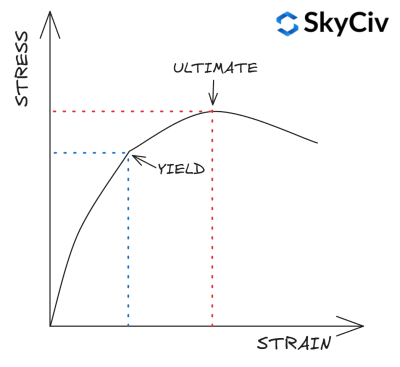
EN 1993-1-1 Table 3.1 provides a simplified approach for calculating the yield and tensile strength of a section based on its grade and thickness. A more detailed material strength calculation can be carried out by referring to the material relevant material standard. The SkyCiv EN 1993-1-1 Steel Member Design module does not use this simplification and instead refers to the relevant materials standards for material strength calculation.
Selecting a Section in SkyCiv EN 1993-1-1 Steel Member Design
The SkyCiv EN 1993-1-1 Steel Member Design tool allows users to select a Standard steel section from the SkyCiv database or design a completely custom section. The program automatically calculates yield strength values for the section flange and web based on the selected steel grade. Users can also adopt a custom steel grade and manually input material properties if required.
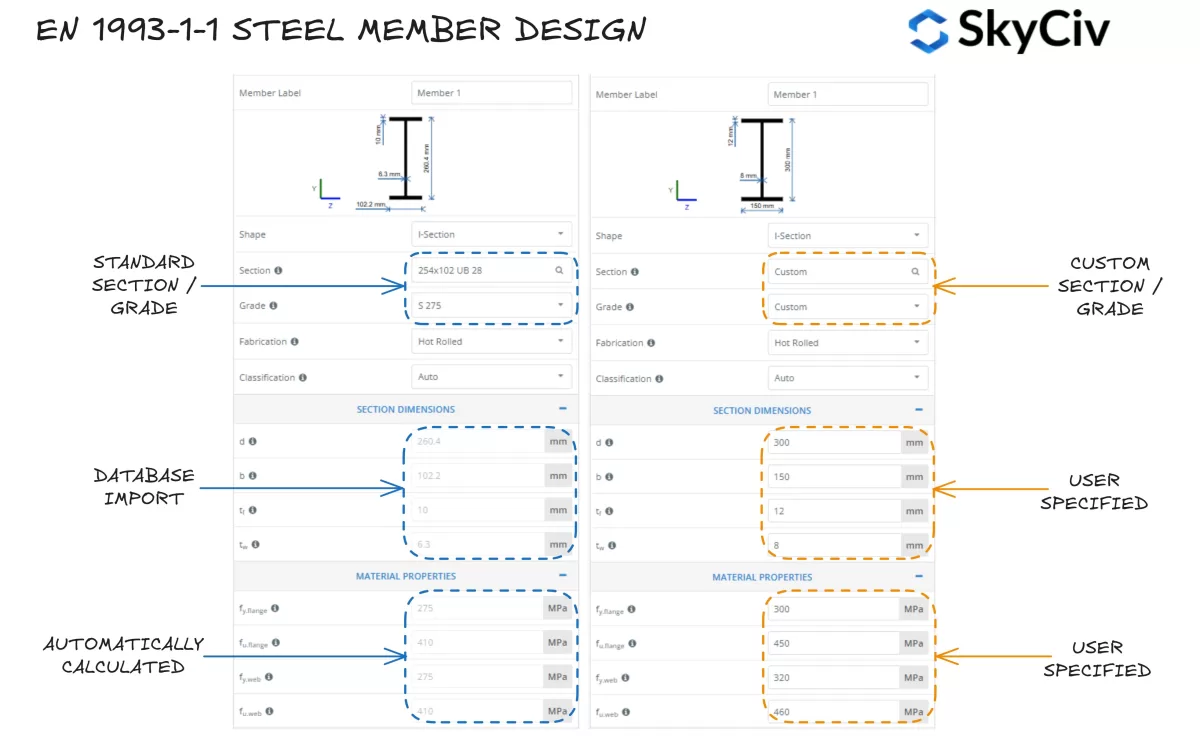
Section Classification
Section Classification is a system used by EN 1993-1-1 to identify the susceptibility of a section to local buckling before attaining its full plastic capacity. Large slender shapes are typically more susceptible to local buckling than small, stocky shapes. The SkyCiv EN 1993-1-1 Steel Member Design tool automatically calculates the classification of standard and custom steel sections based on the applied loading conditions. Eurocode 3 has four Section Classification categories:
- Class 1: Sections that can form a plastic hinge and develop their plastic moment/axial resistance, meaning the entire section can reach its yield strength under bending and/or compression. Class 1 sections also have high rotational capacity. Plastic section properties are used in capacity calculations.
- Class 2: Sections with the ability to form a plastic hinge but have limited rotational capacity. Eurocode 3 treats Class 1 and Class 2 sections similarly for almost all capacity calculations.
- Class 3: Sections that can reach yield strength in their extreme compressive fibre, but buckle locally before plastic moment resistance is achieved. Elastic section properties are used in capacity calculations.
- Class 4: Local buckling will occur before yield strength is reached in part/s of the section. Reduced elastic section properties are used in capacity calculations.
Note, Class 4 sections include additional complexity in calculation of section properties / resistance and are not covered in this guide.
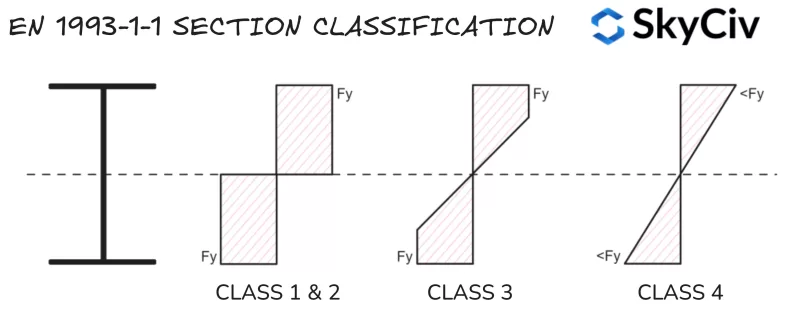
Compression Elements
Section classification is determined by breaking a section into a series of compression elements and calculating their slenderness (clear length relative to thickness). Elements are classified as either:
- Internal: Restrained against buckling at both ends – i.e. web of an I-Section.
- Outstand: Only restrained against buckling at one end – i.e. flange of an I-Section.
The calculated slenderness values are compared to Table 5.2 in EN 1993-1-1 to determine their class. The classification of the section is taken as the least favourable classification of its compression elements. Note, section classification changes depending on the forces on the section (particularly varying axial force). Methods for classifying each type of loading are summarised below.
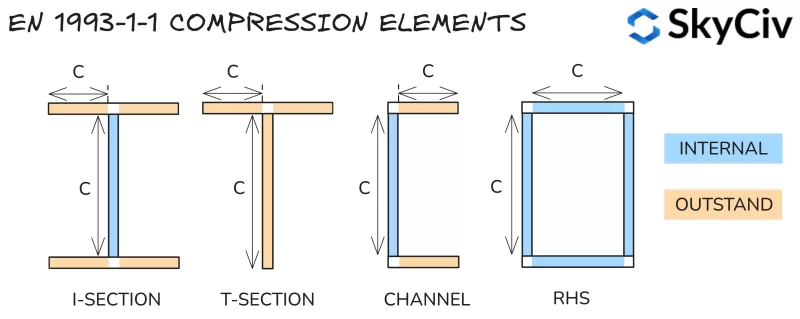
Classification Ratios
Parts Subject to Compression
Elements in pure compression are classified based on their slenderness only using the limits outlined below.
| Class | Internal Parts | Outstand Parts | |
| 1 | c / t ≤ 33ε | c / t ≤ 9ε | |
| 2 | c / t ≤ 38ε | c / t ≤ 10ε | |
| 3 | c / t ≤ 42ε | c / t ≤ 14ε | |
Where:
\(ε = \sqrt{\frac{235}{f_y}}\)
Parts Subject to Bending
Internal elements in pure bending are classified based on their slenderness the limits outlined below.
| Class | Internal Parts | |
| 1 | c / t ≤ 72ε | |
| 2 | c / t ≤ 83ε | |
| 3 | c / t ≤ 124ε | |
Outstand elements subject to pure bending are classified based on the ratio of compressive and tensile stress under the bending moment value resulting in compressive stress equal to yield stress at the extreme fibre. The method for calculating this ratio is detailed in the section below.
Parts Subject to Compression & Bending
Elements subject to combined compression and bending are classified based on their compressive / tensile stress distribution under the applied compression loading. This ratio is represented by the α symbol for plastic stress distribution and ψ symbol for elastic stress distribution.
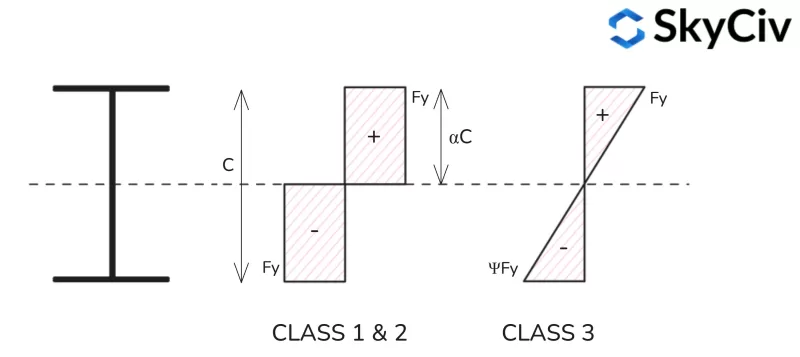
Plastic Stress Distribution
Formulae for calculating plastic stress ratio (α) for different shape profiles are provided below.
I-Section Plastic Stress Distribution

T-Section Plastic Stress Distribution
Note minor axis stress distributions for T-Sections are similar to those of an I-section.

Channel Plastic Section Stress Distribution
Note major axis stress distributions for T-Sections are similar to those of an I-section.

RHS Plastic Stress Distribution

Elastic Stress Distribution
Elastic stress distribution calculations are similar for all sections and shapes, due to the linear stress distribution between the extreme fibres. The formula for calculating the minimum stress in a section under applied compression and bending is shown below.
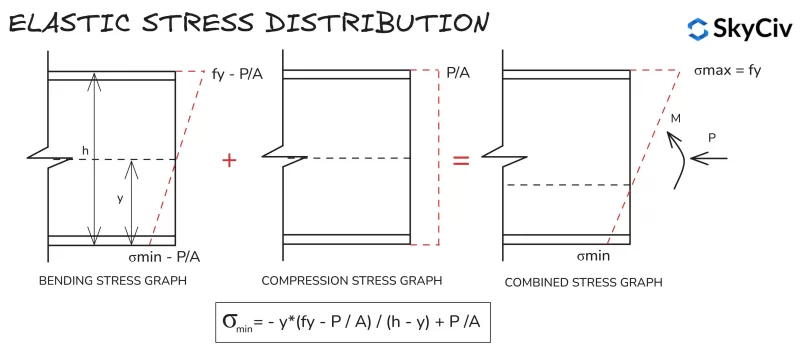
Section Classification in SkyCiv EN 1993-1-1 Steel Member Design
The SkyCiv EN 1993-1-1 Steel Member Design tool automatically determines the Section Classification of standard and custom sections based on the user-input loading. An example output for a Grade S 275, 430x100x64 Channel with 20kN of compression loading is detailed below.
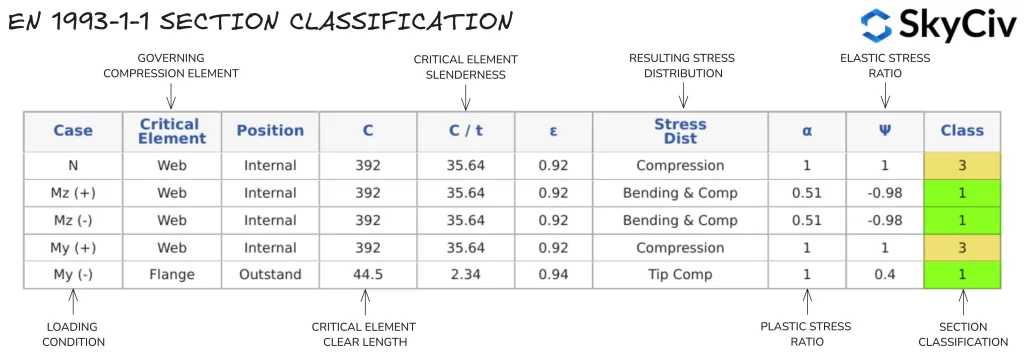
A single Section Classification value is used for all calculations based on the applied axial force and direction of applied bending moment. If a member has bending moment applied about both axes, the most conservative classification from each direction is adopted. Users can also override the automatic calculation of Section Classification and specify a classification manually.
Note, Clause 5.4.1(3) specifies that singly symmetric sections (such as T-sections and Channels) cannot be designed using plastic analysis when bent about their non-symmetric axis. Hence sections of this nature are automatically assigned Class 3.
Section Resistance
Bending
Section Bending Resistance
Section bending moment capacity is calculated using EN 1993-1-1 Clause 6.2.5.
\(M_{c,Rd} = W*f_y/γ_{M0}\)
Where W is the plastic section modulus (Wpl) for Class 1 & 2 sections, or the elastic section modulus (Wel) for Class 3 sections, fy is the yield stress of the material and γ is the partial safety reduction factor.
The section modulus of a shape is a geometric property which quantifies the bending resistance of a shape. The plastic section modulus assumes that the entire section reaches its yield strength under bending. The plastic section modulus of a section is calculated as follows:
\(W_{pl} = A_{C} * y_{C} + A_{T} * y_{T} \)
Where AC and AT are the areas on either side of the Plastic Neutral Axis (PNA), and yc / yt are the distance from the PNA to the centroid of those areas. Note, the PNA location is equal to the geometric centroid location for symmetric shapes but will not equal the geometric centroid location for asymmetric shapes.
The elastic section modulus assumes the entire section (shape) remains elastic under bending, i.e. no part of the section exceeds the yield strength (fy) of the material. The elastic section modulus of a section is calculated as follows:
\(W_{el} = \frac{I}{y}\)
Where I is the second moment of area and y is the geometric centroid of the shape. Note for an asymmetric shape, the elastic modulus value used in design is the lesser value for positive and negative bending about that axis.
Calculating Section Bending Resistance in SkyCiv EN 1993-1-1 Steel Member Design
Once the relevant Section Classification has been calculated, the module calculates the section bending moment capacity (Mc) about each principal axis. Results for the same 430x100x64 Channel are shown in the example below.

Shear
Section Shear Resistance
Shear resistance is calculated using EN 1993-1-1 Clause 6.2.6. Capacity calculations are dependent on the Section Classification of the steel member. Capacity for Class 1 & 2 sections are calculated based on plastic shear resistance, whereas an elastic shear resistance is used for Class 3 & 4 sections.
Plastic shear resistance is calculated using the formula below:
\(V_{pl,Rd}=A_v * (f_y / \sqrt{3}) / γ_{M0}\)
Where Av is the shear area of the section in the direction of applied shear force. For most sections this area is equivalent to the area of the web for major axis direction shear, and the area of the flanges for the other direction. Formulae for calculating shear area are provided in EN 1993-1-1 Clause 6.2.6(3).
Elastic shear resistance is calculated using the relationship below, which ensures the shear stress at the critical point of the cross-section is less than the yield stress.
\(τ_{Ed}/(f_y / (\sqrt{3 * γ_{M0}})) ≤ 1\)
The shear stress at this critical point is calculated as follows:
\(τ_{Ed}=(V_{Ed} * S)/(I * t)\)
Where VEd is the applied shear force, S is the first moment of area, I is the section moment of area and t is the thickness at the critical stress location.
The elastic shear stress formula can then be arranged to represent a resistance value (in kN):
\(V_{el,Rd} = (I * t * \sqrt{3})/(S * f_y)\)
Shear Buckling
Long, slender webs may buckling under applied shear force before they reach their elastic shear resistance. Webs are susceptible to shear buckling if they satisfy the formula below from EN 1993-1-1 Clause 6.2.6(6):
\(h / t > 72 * ε/η \)
Where η is a factor usually taken as 1.0. Webs susceptible to shear buckling must be checked in accordance with Section 5 of EN 1993-1-5. Note, shear capacity in accordance with EN 1993-1-5 is not covered in the SkyCiv EN 1993-1-1 tool, but a warning will be displayed if a section is susceptible to shear buckling.
Impact of Shear Force on Bending & Compression Resistance
High applied shear force can have a negative impact on the moment and axial resistance of a section. In EN 1993-1-1, this impact is captured by reducing the yield strength of the section relative to the magnitude of the applied shear (refer Clause 6.2.8 & 6.2.10). When the section shear force is less than half its plastic shear resistance in that direction, this impact can be neglected. If the applied shear is greater than this value, the reduced yield strength is calculated as follows:
\(f_{y,Rd} = (1 -ρ) * f_y \)
Where:
\(ρ = (2 * V_{Ed} / V_{pl,Rd} – 1)^2\)
The SkyCiv EN 1993-1-1 Steel Member Design module automatically calculates any reduction in yield strength due to high applied shear force and uses this reduced value in section bending and compression resistance calculations. Note, this reduction only applies for the section resistance of a member, not the buckling resistance.
Calculating Shear Resistance in SkyCiv EN 1993-1-1 Steel Member Design
The SkyCiv EN 1993-1-1 Steel Member Design tool calculates the shear capacity of a section in both principal axis directions. Results from the shear resistance calculations for a 254×102 UB 28 are detailed below.

Compression
Section Compression Resistance
EN 1993-1-1 Clause 6.2.4 calculates the compression capacity (Nc) of a concentrically loaded Class 1,2 or 3 section as follows:
\(N_{c,Rd} = A*f_y / γ_{M0}\)
Where A is the gross area of the cross section and fy is the yield strength of the section.
Calculating Section Compression Resistance in SkyCiv EN 1993-1-1 Steel Member Design
The SkyCiv En 1993-1-1 Steel Member Design tool calculates the section compression resistance (Nc,Rd) for standard European sections and custom user-defined sections. Results from the section compression resistance calculations for a 254×102 UB 28 are detailed below.

Tension
Section Tension Resistance
EN 1993-1-1 Clause 6.2.3 calculates the capacity of a tension member (Nt) to be the lesser of the plastic tension resistance and ultimate tension resistance:
\(N_{t,Rd} = min(A*f_{y}/γ_{M0} \; ,\; 0.9*A_{n}*f_u /γ_{M2})\)
Where A is the gross area of the section, An is the net area of the cross section (gross area excluding penetrations/holes), fy is the yield strength of the section, fu is the tensile (ultimate) strength of the section.
Calculating Tension Resistance in SkyCiv EN 1993-1-1 Steel Member Design
The SkyCiv EN 1993-1-1 Steel Member Design module assumes no significant holes are present in the section, hence An is taken as equal to A. Results from the section tension resistance calculations for a 254×102 UB 28 are detailed below.

Bending & Axial Force
When a section has applied axial tension or compression force, the effect of this force on the section bending moment resistance should be accounted for. The method for assessing this effect outlined in EN 1993-1-1 Clause 6.2.9 varies for Class 1 & 2 and Class 3 sections.
Class 1 & 2 Sections
Combined bending and axial force is assessed for Plastic sections by reducing the plastic moment resistance in each direction by an amount proportional to the axial force. This reduced moment resistance is referred to by the symbol MN,Rd. Calculation of MN,Rd varies depending on the section shape and is outlined in EN 1993-1-1 Clause 6.2.9.1. Once reduced moment resistance is calculated, the following criterion is used for assessing combined bending and axial resistance:
\( (M_{y,Ed} / M_{Ny,Rd})^α + (M_{z,Ed} / M_{Nz,Rd})^ β ≤ 1\)
Where α and β are constants that vary with the section shape – refer EN 1993-1-1 Clause 6.2.9.1.
Class 3 Sections
Combined bending and axial force in Elastic sections is instead assessed using a general elastic stress formula detailed below:
\( N_{Ed} / N_{c,Rd} + M_{z,Ed} / M_{cz,Rd} + M_{y,Ed} / M_{cy,Rd} ≤ 1\)
Note any reduction in yield strength required due to applied shear force should be used in calculation of the section resistance values in the formulae above.
Buckling Resistance
Bending
Lateral Torsional Buckling Resistance
Long, unrestrained steel members can fail in lateral-torsional buckling prior to attaining their section bending moment resistance. Lateral torsional buckling occurs when the section rotates away from its major axis towards its minor axis, meaning moment resistance in the direction of applied bending is reduced. Guidance for calculating member lateral-torsional buckling resistance is provided in EN 1993-1-1 Clause 6.3.2.
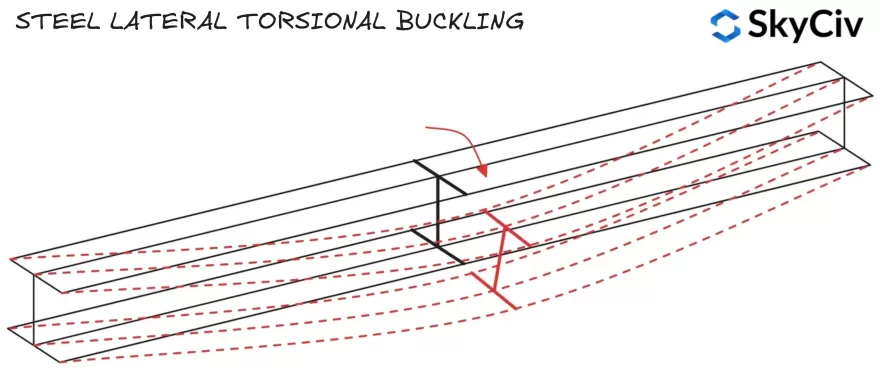
Lateral-torsional buckling resistance is calculated using the below formula:
\(M_{b,Rd} = χ_{LT}*W*f_y/ γ_{M1}\)
Where W is the plastic section modulus (Wpl) for Class 1 & 2 sections, or elastic section modulus (Wel) for Class 3 sections. χLT is a reduction factor for lateral-torsional buckling, guidance for calculating this factor is provided in EN 1993-1-1 Clause 6.3.2.2 and 6.3.2.3.
Compression Flange
Members fail in lateral-torsional buckling when the compression flange rotates and displaces laterally. If the compression flange of a member is sufficiently restrained, it will not be susceptible to lateral torsional buckling (refer EN 1993-1-1 Clause 6.3.2.1(2)). Compression flange locations for standard sections under vertical loading are shown below.
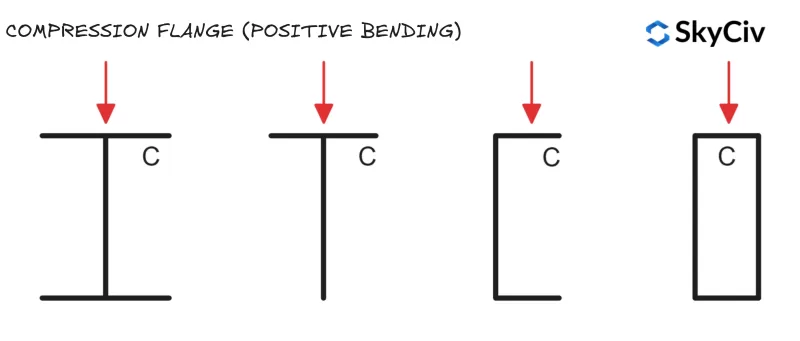
Circular Hollow Sections (CHS) and Square Hollow Sections (SHS) are not susceptible to lateral torsional buckling, as they have equal section moment resistance about both axes (meaning lateral displacement and rotation don’t affect the member bending resistance).
Lateral Torsional Buckling Reduction Factor
χLT is calculated in EN 1993-1-1 using either Section 6.3.2.2 (General Case) or Section 6.3.2.3 (Rolled Sections or Equivalent Welded Sections). Section 6.3.2.3 is applicable for all “standard” sections and shapes (including hollow sections) and their welded equivalents. Section 6.3.2.2 is applicable to any section that doesn’t fall into the former category, including custom fabricated and built-up sections.
Section 6.3.2.2 uses Equation 6.56 for calculation of the lateral torsional buckling reduction fact0r χLT whereas Section 6.3.2.3 uses Equation 6.57. The SkyCiv EN 1993-1-1 Steel Member Design module follows the logic outlined below for application of Equation 6.56 and 6.57.
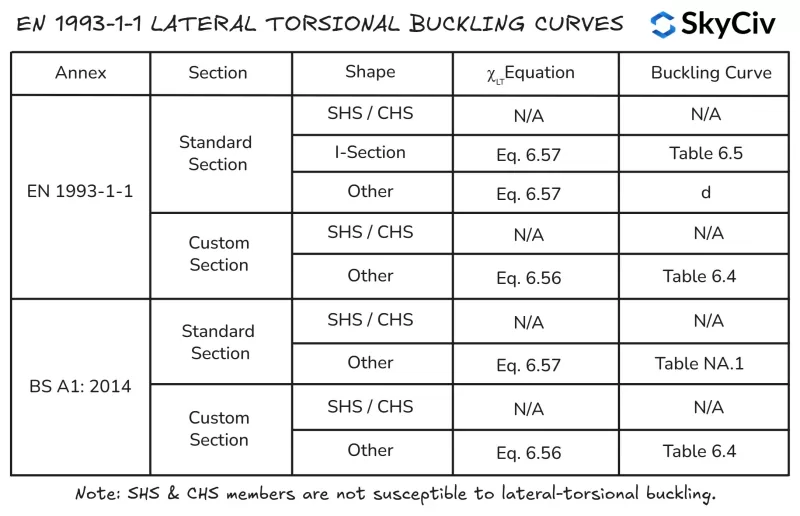
Minor Axis Bending Buckling Resistance
The bending capacity for a member bent about its minor axis is equal to the minor axis section resistance about that axis. The minor axis section capacity is the minimum capacity a section can achieve about any axis, hence the member cannot rotate from this axis into a less-favourable orientation.
Calculating Member Bending Resistance in EN 1993-1-1 Steel Member Design
The SkyCiv EN 1993-1-1 Steel Member Design tool calculates carries out lateral-torsional resistance calculations in accordance with EN 1993-1-1 Clause 6.3.2.2 and Clause 6.3.2.3, depending on the section shape and applied National Annex. Users also have the option to specify a member as having “Continuous Torsional Restraint” which will automatically skip all lateral-torsional buckling checks. Lateral-torsional buckling resistance calculations for a 5000mm long 254×102 UB 28 are detailed below.

Compression
Flexural Buckling Resistance
The compression buckling resistance of a member is also affected by its length and lateral rigidity. Unrestrained, longer members are likely to fail due to flexural buckling before the section (squash) capacity is reached. EN 1993-1-1 Clause 6.3.1.3 provides guidance on calculating member flexural buckling resistance for Class 1, 2 & 3 cross-sections:
\(N_{b,Rd} = χ*A*f_y/ γ_{M1}\)
Where χ is a reduction factor for flexural buckling. Guidance for calculating this factor is provided in EN 1993-1-1 Clause 6.3.1.3. Flexural capacity must be checked about both axes to find the governing value for the member.
Calculating Flexural Buckling Resistance in EN 1993-1-1 Steel Member Design
The SkyCiv EN 1993-1-1 Steel Member Design tool calculates flexural buckling resistance about both principal axes based on restraint lengths and effective length factors specified by the user. Flexural buckling resistance of a 254×102 UB 28 with an unrestrained length of 6000mm and 5000mm in the Z and Y axis (respectively) are detailed below.

Torsional-Flexural Buckling Resistance
Open cross-sections are also susceptible to torsional-flexural buckling, which can be less than the member resistance to flexural buckling. Circular Hollow Sections (CHS) and Square Hollow Sections (SHS) members are not susceptible to torsional-flexural buckling. EN 1993-1-1 Clause 6.3.1.4 provides guidance on calculating member torsional-flexural buckling resistance:
\(N_{bT,Rd} = χ_T*A*f_y/ γ_{M1}\)
Where χLT is a reduction factor for torsional-flexural buckling. Guidance for calculating this factor is provided in EN 1993-1-1 Clause 6.3.1.3. Flexural capacity must be checked about both axes to find the governing value for the member.
Calculating Torsional-Flexural Buckling Resistance in EN 1993-1-1 Steel Member Design
The SkyCiv EN 1993-1-1 Steel Member Design tool calculates torsional-flexural buckling resistance for applicable open and closed sections in accordance with EN 1993-1-1 Clause 6.3.1.4 based on compression restraint length in the major axis as specified by the user. Torsional-flexural buckling resistance of a 254×102 UB 28 with an unrestrained length of 6000mm are detailed below.

SkyCiv Structural Design Software
SkyCiv offers a wide range of Structural Analysis and Engineering Design Software, including:
-
- Eurocode 3 Steel Design
- Eurocode 9 Aluminium Design
- Eurocode 3 Purlin Design
- Eurocode 3 Bolt Group Calculator
- Eurocode 3 Weld Group Calculator
- Eurocode 2 Development Length Calculator
- Eurocode 2 Lap Length Calculator
- Eurocode 5 Timber Design Calculator
- Eurocode 3 Scaffold Design Calculator
Software Developer | Structural Engineer
BEng (Civil), DipEng (Software)



